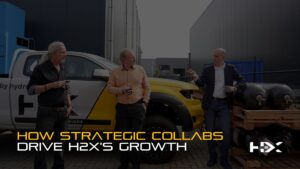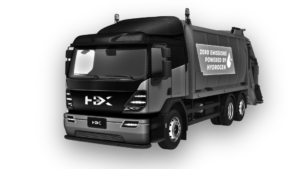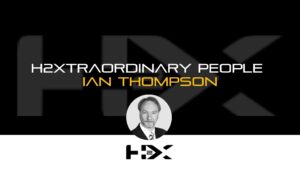Dear Stakeholders,
As we reflect on 2024, I am proud to highlight the progress H2X Global has made in reshaping our business and accelerating our vision to transform commercial vehicles with zero-emission hydrogen power. This has been a year of strategic realignment, financial discipline, and results, all of which have laid a strong foundation for 2025 to also be an incredible year.
2024: A Year of Strategic Focus and Operational Efficiency
At the beginning of the year, we made the pivotal decision to shift our focus and pause the development of the Darling Van to concentrate on immediate deliverables: the Warrego and our retrofit strategy. By consolidating our engineering site, we have achieved cost savings while accelerating development and operational improvements across the board.
This strategic refocus has already delivered measurable financial improvements:
- Expense Reduction of $2.8M (41% decrease): Through workforce adjustments and targeted cost-saving initiatives, we reduced employment costs by $2.2M (50% decrease), optimising our operations and enhancing efficiency.
- Reduction in Professional Fees and IT Costs (30% decrease): By reassessing our advisory relationships, we have streamlined services and reduced related expenses.
- Net Asset Growth of Over $1.5M (200% increase): Our restructuring efforts have directly contributed to this growth, strengthening our financial position.
- Liability Reduction of Over $2M (40% decrease): We have actively addressed outstanding debts, enhancing financial stability and liquidity, positioning H2X for future expansion.
These financial improvements reflect our commitment to maintaining a lean, focused operation and building a more efficient business.
Warrego Development and Strategic Partnerships
The Warrego, the world’s only hydrogen-powered 4×4, has already garnered global attention, ranking #12 on TopSpeed’s “15 Hydrogen Cars to Look Out For.” With the first Warrego now in the final stages of roadworthiness testing, we are on the cusp of delivering a truly innovative, zero-emission vehicle to the market.
The addition of James Walker to the H2X Board has been instrumental in refining our strategy and preparing the company for an eventual public listing. His decades of experience in scaling high-growth businesses, IPOs, and M&A transactions has already been invaluable.
In 2024, we also welcomed Georg Zembacher, European Chief Innovation Officer at Toyota’s Innovation and Solutions Division, as a Non-Executive Director. His expertise in hydrogen and electrification solutions, drawn from his experience at Toyota, Siemens, and AVL, aligns perfectly with our mission to transition from diesel to zero-emission technologies. Georg’s insights will be critical in advancing H2X’s growth trajectory.
Challenges and Adaptation
While 2024 has been a year of progress, it has not been without its challenges. The stalled funding deal with Verde Mobility required us to adapt quickly, leading to tough but necessary decisions to maintain momentum. By focusing on the Warrego and retrofit opportunities, we have created immediate value and solidified our market position. Our agility and resilience will continue to define H2X as we transition into full vehicle production.
Looking Ahead to 2025
As we move into 2025, our primary focus is scaling production and fulfilling our commitments. With the Warrego nearing roadworthy completion, we are preparing for deliveries and ramping up production.
Additionally, the development of the Paroo truck is underway, further demonstrating our ability to scale hydrogen-powered solutions across multiple vehicle classes. Retrofitting remains a cornerstone of H2X’s phased business plan, allowing us to accelerate market entry while avoiding the substantial capital and time investments required for full-scale manufacturing from the ground up. This approach provides a proof of concept for our hydrogen-electric vehicles, instilling market confidence and laying the groundwork for future growth.
The Paroo truck’s “Retrofit Ready” design, arriving without an engine, transmission, or fuel system, allows us to seamlessly integrate our hydrogen powertrain technology. This brings us closer to producing fully proprietary vehicles and solidifies our technical leadership in the hydrogen vehicle sector.
IPO and Funding Requirements
As we prepare for H2X’s IPO on the AIM market of the London Stock Exchange in 2025, we continue to lay the groundwork for this significant milestone. We have engaged leading intermediaries, including auditors, legal experts, and Nomad advisors, to ensure a smooth and successful listing.
The IPO will provide H2X with access to capital, enabling us to scale our operations, optimise inventory ordering, and increase gross margins. Meeting the disclosure and governance standards required of a listed company will further strengthen our reputation and appeal to customers and partners worldwide.
In the meantime, we are raising funds to support the retrofit of our next wave of ordered vehicles and to cover the initial IPO costs. Securing additional funding now is critical to maintaining the momentum we have built. We sincerely thank our existing investors for their support thus far. Qualifying investors who wish to participate in this round, please contact H2X or our lead manager, Barclay Pearce Capital (BPC). Your continued support is essential to enabling us to execute our strategy and lead the global shift to hydrogen-powered transportation.
Recognition
We were honoured to receive the 2024 AFR BOSS Most Innovative Companies Award in the “Property, Construction, and Transport” category, coinciding with World Hydrogen Day. This recognition is a testament to the innovative work behind the Warrego’s development and reinforces H2X’s position as a leader in the hydrogen vehicle market.
Additionally, I had the privilege of visiting Toyota’s hydrogen fuel cell facility in Japan with our Chair, James Walker. This visit strengthened our partnership with Toyota and underscored the crucial role their technology plays in advancing H2X’s vehicles.
Conclusion
2024 has been a transformative year for H2X, marked by strategic decisions, financial discipline, and tangible progress. Our foundation is strong, our vision is ambitious, and with your continued support, we are poised to lead the global transition to hydrogen-powered transportation.
Thank you for being part of this journey.

Warm regards,
Antony Tolfts
CEO, H2X Global Limited






















